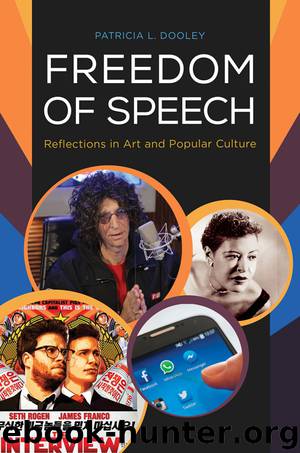Freedom of Speech by Dooley Patricia L.;

Author:Dooley, Patricia L.;
Language: eng
Format: epub
Publisher: ABC-CLIO, LLC
Rod Gilchrist, director of the Cartoon Art Museum, and curator Jenny Dietzen read a cartoon strip from The Boondocks by artist Aaron McGruder, in San Francisco, February 25, 2003. The strip was part of an exhibit at the museum called “Hate Mail: Comic Strip Controversies” that looked at how newspapers, artists, and readers have dealt with controversial subjects in the funny papers. (AP Photo/Ben Margot)
The Boondocks is but one of a number of controversial comic strips. Comics were first published in the United States during the waning years of the 19th century. Because of the accessibility of comic strips to young people, most of their publishers warned their creators to refrain from including in them certain words and images considered unsuitable. In the late 1940s, as fears of the spread of communism grew, publishers of comic strips sought to avoid the attention of Congressional committees bent on eliminating threats to the country’s security. In 1947, Scripps-Howard censored Li’l Abner because of the way it portrayed U.S. Senators in a negative light. In a September 29, 1947, Time magazine article, Scripps-Howard executive Edward Leech was quoted as saying, “We don’t think it good editing or sound citizenship to picture the Senate as an assemblage of freaks and kooks … boobs and undesirables.”
The Boondocks became an animated television sitcom that ran from 2005 to 2014. Its producers returned to the 9/11 controversy in the episode “The Garden Party” with the line, “Jesus is Black, Reagan was the devil, and the government is lying about 9/11.”
GRAFFITI ART BLU CLASHES WITH A RENOWNED ART MUSEUM DIRECTOR (2011)
Street art is produced by artists who use the sides of buildings, fences, and other nontraditional art venues as canvases for their creations. Art historians have documented the roots of today’s street art movement in the graffiti of mid-20th century New York City gang members and the work of others with a penchant for this form of expression. In the 1970s and 1980s, in reaction to the time’s unsettling sociopolitical environment, young people across the nation started a new chapter in the movement. Eventually, examples of these illegal works of art found their ways into galleries and the broader art market. Although not everyone appreciates street art, many art enthusiasts and professionals believe it has earned a place in the contemporary art world.
Reactions to street art have varied from condemnation to acclaim. An example of street artist censorship took place in Los Angeles in 2010–2011. Blu, an internationally known Italian street artist, was invited by Jeffrey Deitch, the director of the Los Angeles Museum of Contemporary Art (MOCA) to paint a mural on the Geffen Contemporary building as part of the Art in the Streets exhibit about graffiti. Blu painted a scene of coffins draped in one-dollar bills to express his antiwar sentiments. Deitch, however, considered the mural inappropriate because it faced a Veterans Administration Hospital as well as a public monument honoring World War II Japanese-American soldiers. Within 24 hours, Deitch’s order to whitewash Blu’s mural had been carried out.
Download
This site does not store any files on its server. We only index and link to content provided by other sites. Please contact the content providers to delete copyright contents if any and email us, we'll remove relevant links or contents immediately.
The Social Psychology of Inequality by Unknown(2777)
Make Comics Like the Pros by Greg Pak(2767)
Stacked Decks by The Rotenberg Collection(2701)
Purple Hibiscus by Chimamanda Ngozi Adichie(2506)
The Queen of Nothing by Holly Black(2335)
The Art of Doom by Bethesda(2043)
Life of Elizabeth I by Alison Weir(1907)
Putin's Labyrinth(1903)
The Power of Habit: Why We Do What We Do in Life and Business by Charles Duhigg(1886)
Things Are What You Make of Them: Life Advice for Creatives by Adam J. Kurtz(1767)
Drawing Down the Moon by Margot Adler(1731)
Agency by William Gibson(1727)
Wall and Piece by Banksy(1725)
The Beatles Lyrics by Hunter Davies(1611)
Only What's Necessary: Charles M. Schulz and the Art of Peanuts by Chip Kidd(1598)
Teaching to Transgress: Education as the Practice of Freedom (Harvest in Translation) by Bell Hooks(1586)
Art Of Atari by Tim Lapetino(1578)
The Andy Warhol Diaries by Andy Warhol(1512)
Pop Manga by Camilla D'Errico(1487)
